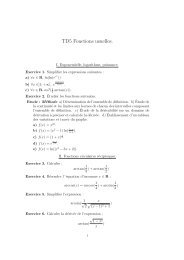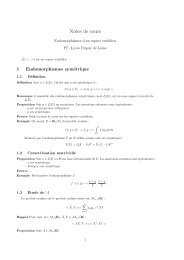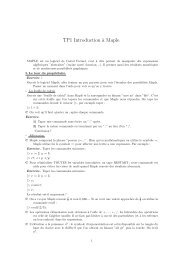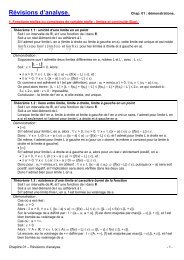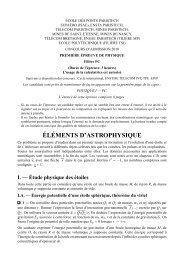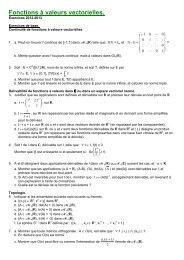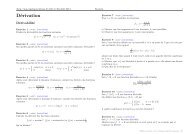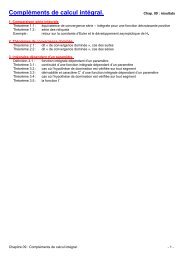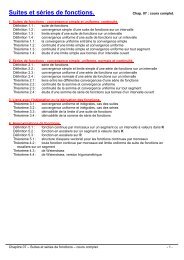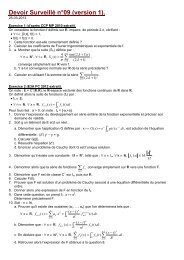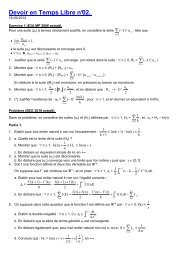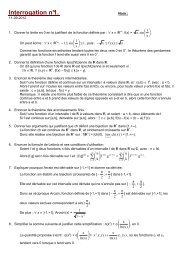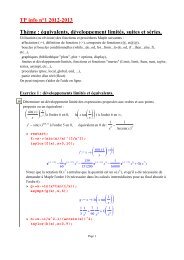[http://mp.cpgedupuydelome.fr] édité le 4 juin 2013 Enoncés 1 ...
[http://mp.cpgedupuydelome.fr] édité le 4 juin 2013 Enoncés 1 ...
[http://mp.cpgedupuydelome.fr] édité le 4 juin 2013 Enoncés 1 ...
You also want an ePaper? Increase the reach of your titles
YUMPU automatically turns print PDFs into web optimized ePapers that Google loves.
[<strong>http</strong>://<strong>mp</strong>.<strong>cpgedupuydelome</strong>.<strong>fr</strong>] <strong>édité</strong> <strong>le</strong> 26 juil<strong>le</strong>t <strong>2013</strong> Corrections 51<br />
Exercice 47 : [énoncé]<br />
I) a) La convergence uniforme donne<br />
et donc <br />
b<br />
a<br />
fn − f∞ = sup |fn(x) − f(x)| → 0<br />
x∈[a,b]<br />
fn(x) dx −<br />
b<br />
a<br />
<br />
<br />
<br />
f(x) dx<br />
(b − a) fn − f∞ → 0<br />
b) S’il a convergence uniforme d’une série de fonctions continues sur [a, b], alors<br />
on peut intégrer terme à terme :<br />
b +∞<br />
a<br />
n=0<br />
fn(x) dx =<br />
+∞<br />
b<br />
n=0<br />
a<br />
fn(x) dx<br />
avec continuité de la fonction somme et convergence de la série des intégra<strong>le</strong>.<br />
Puisque la série entière xn est de rayon de convergence R = 1, cette série de<br />
fonctions converge norma<strong>le</strong>ment et donc uniformément sur [0, 1/2] ⊂ ]−1, 1[ et on<br />
en déduit<br />
1/2 +∞<br />
x n +∞ 1 1<br />
dx =<br />
n + 1 2n+1 0<br />
n=0<br />
II) a) Soit x ∈ ker u ⋆ . Pour tout y ∈ Imu, on peut écrire y = u(a) et<br />
(x | y) = (u ⋆ (x) | a) = (0 | a) = 0 donc ker u ⋆ ⊂ Imu ⊥ .<br />
Soit x ∈ Imu ⊥ , ∀a ∈ E, (u ⋆ (x) | a) = (x | u(a)) = 0 donc u ⋆ (x) = 0 d’où<br />
Imu ⊥ ⊂ ker u ⋆ .<br />
Puisque u ⋆⋆ = u on a aussi Imu ⋆⊥ = ker u d’où Imu ⋆ = ker u ⊥ .<br />
b) On a évidemment ker u ∩ ker u ⋆ ⊂ ker(u + u ⋆ ).<br />
Inversement, soit x ∈ ker(u + u ⋆ ). On a u(x) = −u ⋆ (x) ∈ Imu ∩ Imu ⋆ .<br />
Or Imu ⋆ = (ker u) ⊥ et, puisque u 2 = 0, Imu ⊂ ker u. Par suite Imu ⋆ ⊂ (Imu) ⊥ et<br />
donc u(x) = −u ⋆ (x) ∈ Imu ∩ (Imu) ⊥ . On en déduit u(x) = u ⋆ (x) = 0.<br />
Fina<strong>le</strong>ment ker(u + u ⋆ ) ⊂ ker u ∩ ker u ⋆ puis l’égalité.<br />
Reste à établir l’équiva<strong>le</strong>nce.<br />
(⇒) Supposons u + u ⋆ inversib<strong>le</strong>.<br />
On a {0} = ker(u + u ⋆ ) = ker u ∩ ker u ⋆ = ker u ∩ (Imu) ⊥ .<br />
Par suite dim ker u + dim(Imu) ⊥ dim E puis dim ker u dim Imu.<br />
Or Imu ⊂ ker u et donc dim Imu dim ker u. Ainsi dim Imu = dim ker u et<br />
puisque Imu ⊂ ker u, on peut conclure Imu = ker u.<br />
(⇐) Supposons Imu = ker u.<br />
ker(u + u ⋆ ) = ker u ∩ ker u ⋆ = Imu ∩ (Imu) ⊥ = {0} donc u + u ⋆ est injectif puis<br />
bijectif.<br />
n=0<br />
Exercice 48 : [énoncé]<br />
I) Si f est de classe C 1 sur un ouvert U alors pour tout (y0, y1) ∈ U, il existe une<br />
unique solution maxima<strong>le</strong> à l’équation y ′′ = f(y, y ′ ) vérifiant y(t0) = y0 et<br />
y ′ (t0) = y1 (on peut éventuel<strong>le</strong>ment proposer un énoncé avec t0 = 0 car il s’agit<br />
d’une équation autonome). De plus, cette solution est définie sur un interval<strong>le</strong><br />
ouvert et toute autre<br />
<br />
solution de ce problème de Cauchy en est une restriction.<br />
II) a) P (ai) = ai (ai − aj). P est de degré n et unitaire donc<br />
n<br />
i=1<br />
P (x)<br />
(x−ai)<br />
j=i<br />
= 1 + n<br />
i=1<br />
ai<br />
x−ai .<br />
b) det A = P (0) = (−1) n−1 (n − 1) n<br />
ai. Notons que l’on peut proposer une<br />
i=1<br />
démarche plus si<strong>mp</strong><strong>le</strong> en commençant par factoriser <strong>le</strong>s ai par colonnes.<br />
Exercice 49 : [énoncé]<br />
I) Solution généra<strong>le</strong> y(x) = C √ x 2 − 1 + 2(x 2 − 1).<br />
II) Soit u un vecteur unitaire tel que a ∈ Vectu et v un vecteur unitaire orthogonal<br />
à v tel que b ∈ Vect(u, v). Il suffit ensuite de travail<strong>le</strong>r dans (u, v, u ∧ v).<br />
Soit x = 0. f(x) = λx ⇔ (λ + 1)x = (a | x)a.<br />
Si x est orthogonal à a alors x est vecteur propre associé à la va<strong>le</strong>ur propre −1.<br />
Sinon x est vecteur propre si, et seu<strong>le</strong>ment si, x est colinéaire à a. Or f(a) = 0<br />
donc a, puis x, est vecteur propre associé à la va<strong>le</strong>ur propre 0.<br />
On reconnaît en f l’opposé de la projection orthogona<strong>le</strong> sur <strong>le</strong> plan de vecteur<br />
normal a.<br />
Exercice 50 : [énoncé]<br />
I) χM = −X(X 2 − ab − bc + ca).<br />
Si ab + bc > ca alors M est diagonalisab<strong>le</strong> dans M3(R) et a fortiori dans M3(C).<br />
Si ab + bc = ca alors 0 est seu<strong>le</strong> va<strong>le</strong>ur propre de M et donc M est diagonalisab<strong>le</strong><br />
si, et seu<strong>le</strong>ment si, M = 0.<br />
Si ab + bc < ca alors M n’est pas diagonalisab<strong>le</strong> dans M3(R) mais l’est dans<br />
M3(C).<br />
II) S(t) est définie sur R\Z.<br />
n−1 2α sin απ<br />
an = (−1)<br />
π(n2 − α2 ) et bn = 0<br />
Par <strong>le</strong> théorème de Dirich<strong>le</strong>t, f(x) coïncide avec sa somme de Fourier sur [−π, π]<br />
car f est éga<strong>le</strong> à sa régularisée.<br />
Diffusion autorisée à titre entièrement gratuit uniquement - dD


![[http://mp.cpgedupuydelome.fr] édité le 4 juin 2013 Enoncés 1 ...](https://img.yumpu.com/19249082/51/500x640/http-mpcpgedupuydelomefr-edite-le-4-juin-2013-enonces-1-.jpg)
